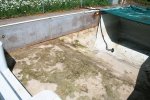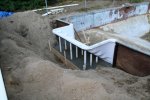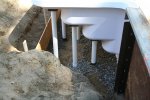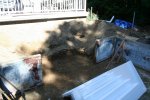Hello, I bought a house with an inground pool 5 years ago, just North of Boston. The pool was built in the late '70's. 16 X 32 rectangle steel wall construction with vinyl liner and fiberglass (I think) steps. The liner is the beaded type with aluminum combination bead receiver and bull nose coping. I actually have all the original documentation from the pool. It was manufactured by Weatherking.
4 years ago, when I went to open the pool, the shallow end only had a couple of inches of water - it looked like the liner leaked at some pinholes in or near the seam between the side wall part and the floor. I had a truck of water delivered to fill the pool and I managed to patch the holes with underwater patches. It's held up well, and I've had to patch a couple more holes over the past few seasons, but the pool never lost very much water over the winters.
This year, the water drained out again over the winter, leaving only a few inches in the shallow end. I am planning on replacing the liner myself, with help from friends and someone who has done liner replacements himself.
I had always noticed a little rust near the skimmer. When I removed the face plate from the skimmer (Hayward wide-mouth) to prepare to remove the old liner, it looks like the steel wall has been in direct contact with the pool water, because there is a lot of rust. There was a gasket between the face plate and the liner, but it does not cover the exposed edges of the steel wall. The water that flows into the skimmer has been in direct contact with the steel wall. There is some rust damage and part of the steel is quite decayed. I assume this was not installed properly. I want to repair the steel wall before replacing the skimmer and liner. I was thinking I could cut out a section of the steel around the skimmer opening and put a new piece of material in, securing it with counter-sunk stainless steel self-tapping screws or bolts.
My questions are:
- Do skimmers have a way of sealing the edge of the steel wall so that water does not come in contact with it?
- Should I use a piece of steel to repair the wall, or is there a water-friendly material that I should use, such as some kind of strong plastic?
My second issue is regarding the steps. The steps protrude outside the perimeter of the pool rectangle (as opposed to projecting into the pool). They are white, are bull nosed at the top (to meet up with the coping) and I believe are made out of fiberglass. They appear to be the original steps and have begun to crack and fade. Since I am replacing the liner, I thought this would be a good time to replace the steps. From what I can tell, it looks like the only mechanical connection is the screws that hold the liner in place. There is a faceplate strip along both sides the bottom edge of the steps that screws through the strip, through the liner and steps and thread into the steel.
My questions are:
- Are these steps manufactured to some standard dimensions so that I can simply drop a new set into place and the support structure underneath with be acceptable?
- Does anyone know of a good source to buy a set of steps as a homeowner as opposed to a pool contractor?
Thanks for any advice you have.
- Tony
4 years ago, when I went to open the pool, the shallow end only had a couple of inches of water - it looked like the liner leaked at some pinholes in or near the seam between the side wall part and the floor. I had a truck of water delivered to fill the pool and I managed to patch the holes with underwater patches. It's held up well, and I've had to patch a couple more holes over the past few seasons, but the pool never lost very much water over the winters.
This year, the water drained out again over the winter, leaving only a few inches in the shallow end. I am planning on replacing the liner myself, with help from friends and someone who has done liner replacements himself.
I had always noticed a little rust near the skimmer. When I removed the face plate from the skimmer (Hayward wide-mouth) to prepare to remove the old liner, it looks like the steel wall has been in direct contact with the pool water, because there is a lot of rust. There was a gasket between the face plate and the liner, but it does not cover the exposed edges of the steel wall. The water that flows into the skimmer has been in direct contact with the steel wall. There is some rust damage and part of the steel is quite decayed. I assume this was not installed properly. I want to repair the steel wall before replacing the skimmer and liner. I was thinking I could cut out a section of the steel around the skimmer opening and put a new piece of material in, securing it with counter-sunk stainless steel self-tapping screws or bolts.
My questions are:
- Do skimmers have a way of sealing the edge of the steel wall so that water does not come in contact with it?
- Should I use a piece of steel to repair the wall, or is there a water-friendly material that I should use, such as some kind of strong plastic?
My second issue is regarding the steps. The steps protrude outside the perimeter of the pool rectangle (as opposed to projecting into the pool). They are white, are bull nosed at the top (to meet up with the coping) and I believe are made out of fiberglass. They appear to be the original steps and have begun to crack and fade. Since I am replacing the liner, I thought this would be a good time to replace the steps. From what I can tell, it looks like the only mechanical connection is the screws that hold the liner in place. There is a faceplate strip along both sides the bottom edge of the steps that screws through the strip, through the liner and steps and thread into the steel.
My questions are:
- Are these steps manufactured to some standard dimensions so that I can simply drop a new set into place and the support structure underneath with be acceptable?
- Does anyone know of a good source to buy a set of steps as a homeowner as opposed to a pool contractor?
Thanks for any advice you have.
- Tony



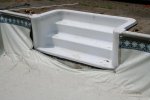
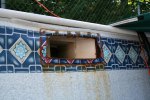

 The stairs should either be replaced or resurfaced (there are companies that can do that
The stairs should either be replaced or resurfaced (there are companies that can do that  You've already mentioned the issue with the safety cover...
You've already mentioned the issue with the safety cover...
